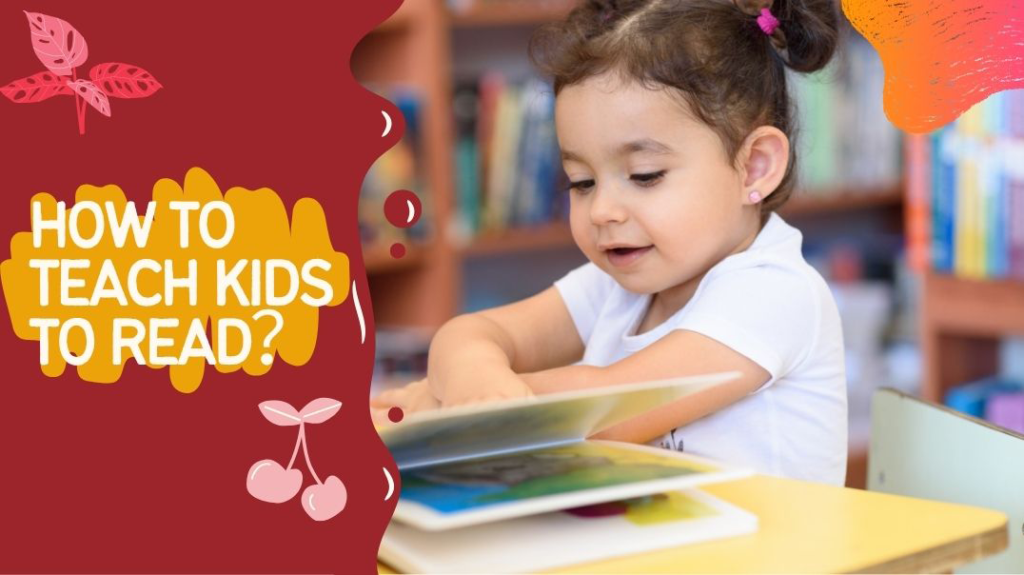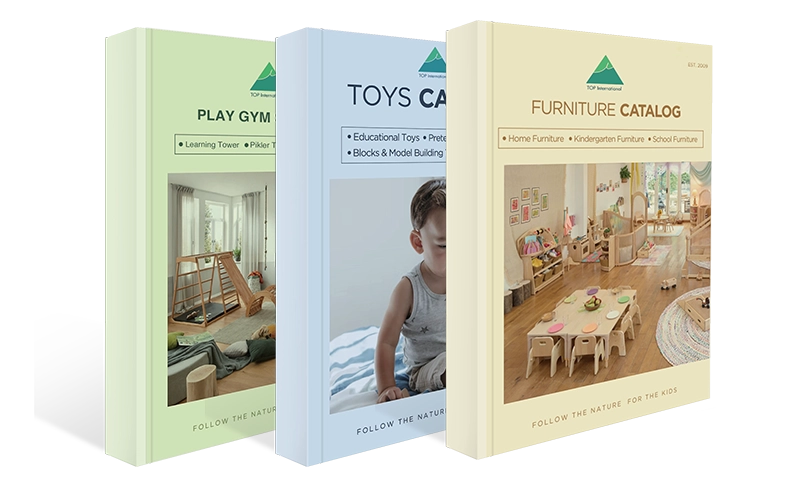How to teach kids to read when every child learns differently? How to teach kids to read if they lose interest quickly? How to teach kids to read when you’re not sure which method works best? Are you wondering when to start, what materials to use, or how to make reading enjoyable for preschoolers?
How to teach kids to read starts by combining structured phonics, picture-rich books, and interactive activities tailored to each child’s pace. This approach doesn’t just teach reading—it improves memory, attention, and language comprehension. Children who learn to read early are more confident, express themselves better, and build stronger problem-solving skills. Plus, early readers tend to perform better academically and develop a more profound love for learning, which supports their long-term educational growth.
Learning how to teach kids to read doesn’t need to be overwhelming. Whether you’re a parent, educator, or kindergarten owner, this article will walk you through proven techniques that work. From classroom tools to home-based strategies, we’ll explore step-by-step how to teach kids to read in ways that are fun, safe, and developmentally appropriate.
Why is Reading Important for Children?
Reading is the foundation for all other learning. Once a child can read, they can explore any subject—math, science, history, even art—on their own. It’s the key that unlocks independent learning. More importantly, it builds vocabulary, improves sentence structure, and strengthens a child’s ability to communicate clearly.
Children who read regularly hear and see thousands more words per day than those who don’t. This extra exposure enhances language development and sets the stage for stronger performance in writing and conversation. Reading aloud to children also improves listening skills, attention span, and comprehension—all vital for success in school.
Beyond academics, reading nurtures emotional intelligence. Through stories, children learn empathy. They encounter characters from different backgrounds and face a variety of emotions and challenges. This helps them understand the world better and relate to others more thoughtfully.
In a well-prepared learning environment, children are free to choose books they love, read at their own pace, and connect reading with enjoyment. When reading is introduced in a calm, supportive setting, it becomes a lifelong habit rather than a task.
Reading also encourages focus and imagination. Unlike screens that offer instant stimulation, reading trains the brain to concentrate, follow a narrative, and think deeply. These skills carry over into every area of a child’s life—from classroom behavior to problem-solving.
Creating an inviting reading area, offering quality picture books, and modeling good reading habits are simple but powerful ways to make a lasting impact on a child’s development. Because when we teach a child to read, we open the door to a lifetime of learning.

The Multiple Benefits of Reading for Child Development
Reading is not just a skill—it’s a doorway to a child’s emotional, social, and intellectual development. In early childhood, when the brain is rapidly forming connections, reading plays a crucial role in shaping how a child thinks, feels, and interacts with others. While many parents and educators see reading as a tool for literacy, its real impact reaches far beyond that. Below are several key developmental benefits that reading offers to young children, each essential for nurturing well-rounded learners and thoughtful individuals.
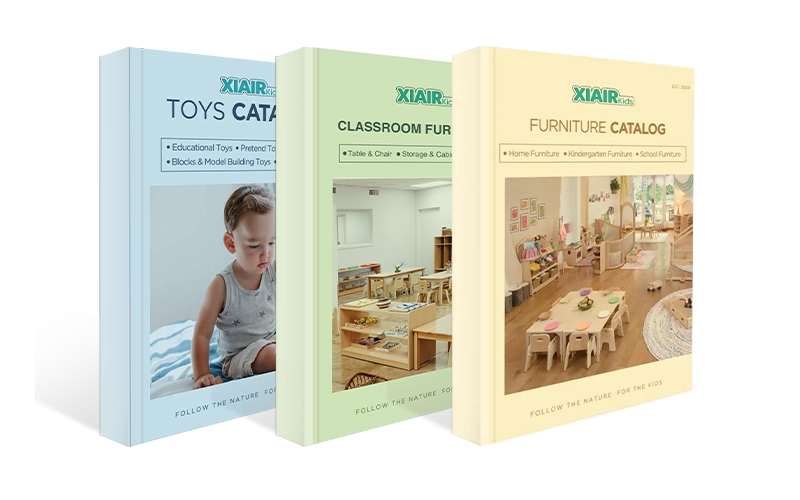
Assisted Cognitive Development
One of the most foundational benefits of reading is the role it plays in cognitive development. When children engage with stories, they are not just absorbing words—they are learning how to think. Reading stimulates brain development by encouraging pattern recognition, memory retention, sequencing, and logical reasoning. These cognitive processes help children make sense of the world around them.
Early exposure to books also accelerates vocabulary acquisition. Children who are read to regularly encounter thousands of unique words per day, compared to those who aren’t. This helps them build a mental word bank that improves comprehension and expression. Furthermore, as they begin to connect words with images, characters with actions, and events with consequences, their critical thinking starts to mature.
Cognitive development through reading is significant during the preschool years. At this stage, the brain is highly plastic, and neural pathways formed through storytelling can set the foundation for future academic success. Structured reading environments—such as reading corners or guided story times—can support and enhance this growth significantly.
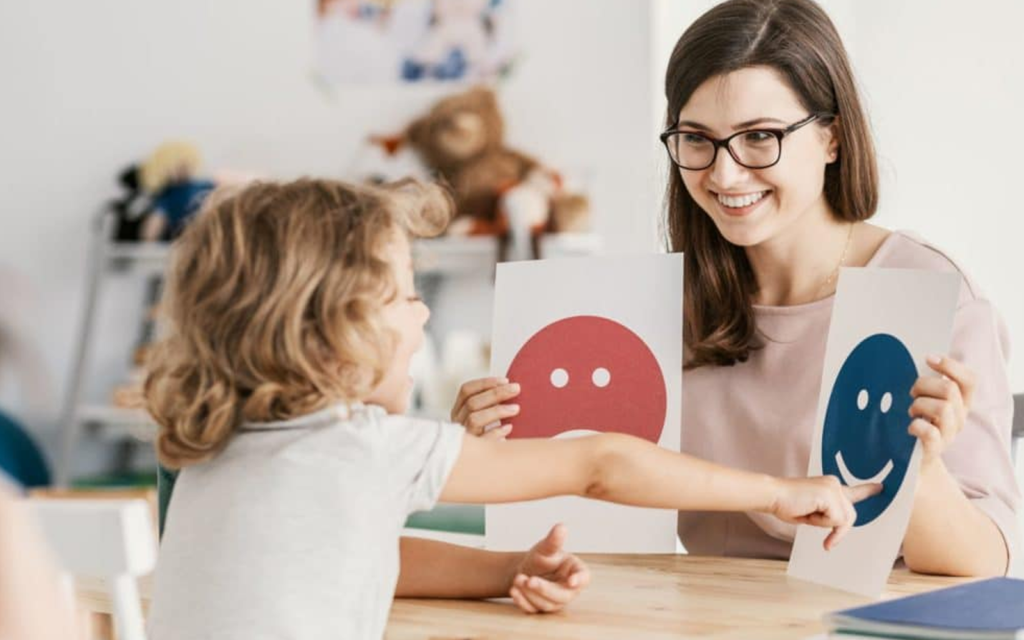
Developing Empathy
Another profound benefit of reading is the way it cultivates empathy. When children read stories, they enter the emotional worlds of characters very different from themselves. Whether it’s a story about a lost puppy, a child facing fears, or a family overcoming hardship, these narratives invite young readers to experience joy, sadness, anxiety, and triumph from someone else’s point of view.
This emotional engagement teaches children how to identify feelings—not just their own, but those of others. They begin to understand that people have different perspectives, backgrounds, and needs. This is particularly important in early social development, where recognizing emotions is the first step toward forming respectful and cooperative relationships.
Picture books are potent tools in this area. Through expressive illustrations and relatable situations, children learn to connect emotions with visual cues, deepening their emotional literacy. When a child can say, “He looks sad because he lost his toy,” they are already practicing empathy. These skills carry forward into real-life social interactions and help create more emotionally intelligent individuals.
Gaining Deeper Understanding
Reading also helps children gain a deeper understanding of the world, far beyond what they can observe directly. Books open the door to cultures, experiences, and ideas that may be entirely unfamiliar to a child. Through stories, they learn about different ways of life, historical events, natural science, and even moral dilemmas.
This exposure builds curiosity and promotes a questioning mindset. When a child reads about animals in the rainforest or children living in other countries, they begin to ask meaningful questions: Why do they live that way? What does that animal eat? Why did the character make that choice?
Such questions spark conversation and exploration, encouraging both independent thought and shared learning. Over time, this nurtures a sense of global awareness, cultural respect, and a desire to learn, not because they have to, but because they want to.

Building Stronger Relationships
Reading is also a deeply relational activity. Whether it’s a parent reading a bedtime story or a teacher leading a classroom read-aloud, the act of reading together creates meaningful, shared moments. These moments help build trust, emotional security, and stronger bonds between children and caregivers.
For young children, the physical closeness of reading with a parent or teacher—sitting side-by-side, listening, asking questions—creates a safe and comforting space. In that space, children are more open to learning, to feeling, and to imagining. These moments are where relationships grow and deepen.
In group settings like kindergartens, shared reading promotes cooperative listening, turn-taking, and communication. Children learn to listen to others’ thoughts and respond respectfully, skills that are essential for later group learning and social integration.

Tips for How to Teach Kids to Read
How to teach kids to read is one of the most essential skills in early childhood education. It requires patience, understanding, and the right combination of strategies tailored to a child’s developmental stage. Teaching reading is not about pushing a child into books before they are ready; it’s about nurturing curiosity, laying strong language foundations, and making literacy a joyful part of everyday life.
Here are several carefully designed tips that can help parents, teachers, and early childhood educators successfully guide children through the early stages of learning to read.
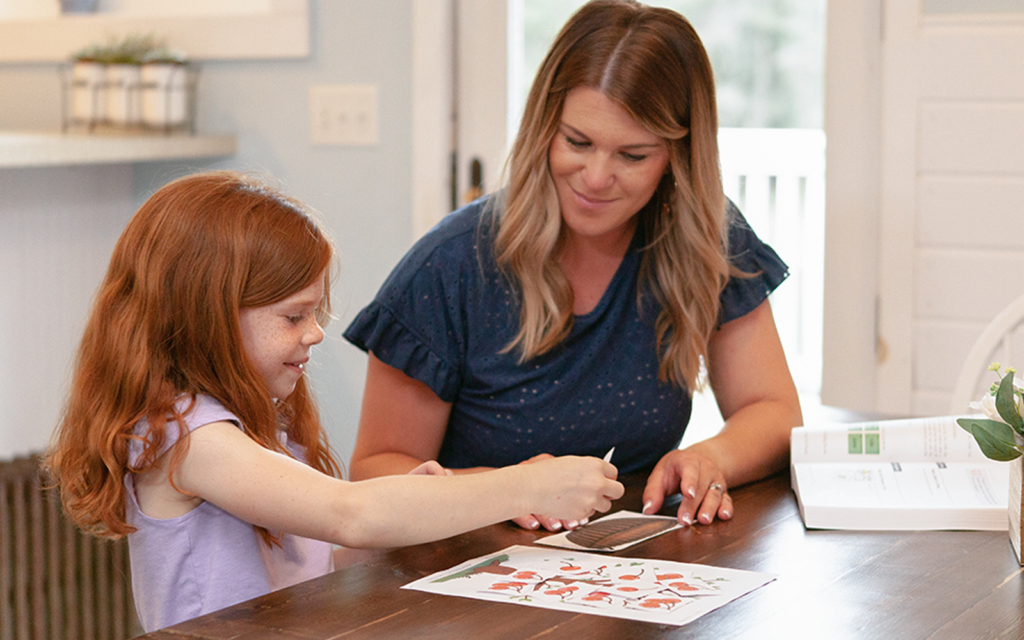
Focus on Letter Sounds over Letter Names
When it comes to how to teach kids to read, one of the most common mistakes is focusing too much on letter names rather than the sounds those letters make. While it may seem logical to begin with the alphabet (A, B, C…), what truly helps children decode words is phonemic awareness—the ability to hear and manipulate the sounds in words.
Children benefit most from learning that the letter B makes a /b/ sound, not just that it’s “bee.” This is the foundation of phonics, and without this understanding, reading becomes about memorization instead of decoding. Letter sounds help children understand how to blend and segment words, allowing them to recognize patterns and read independently.
You can incorporate letter sounds through songs, chants, hands-on games, and sound-matching activities. Start small, focus on a few familiar consonant sounds, and gradually build from there. This gives children the tools they need to sound out new words confidently.
Begin with Uppercase Letters
Many parents wonder which letters to teach first. Surprisingly, it’s often best to start with uppercase letters. Why? Because uppercase letters are typically more visually distinct and more straightforward to recognize for young children. The straight lines and simple shapes are less confusing than their lowercase counterparts, which often look similar (like “b” and “d”).
Teaching uppercase letters first can make early reading and writing more accessible and less frustrating. Use tactile materials—like sandpaper letters, wooden cutouts, or chalkboards—to reinforce learning through multiple senses. Once uppercase letters are solid, you can introduce lowercase forms as children become more comfortable with letter recognition.
This approach also aligns well with Montessori and Reggio-inspired learning environments, where children explore literacy through natural, hands-on experiences at their own pace.
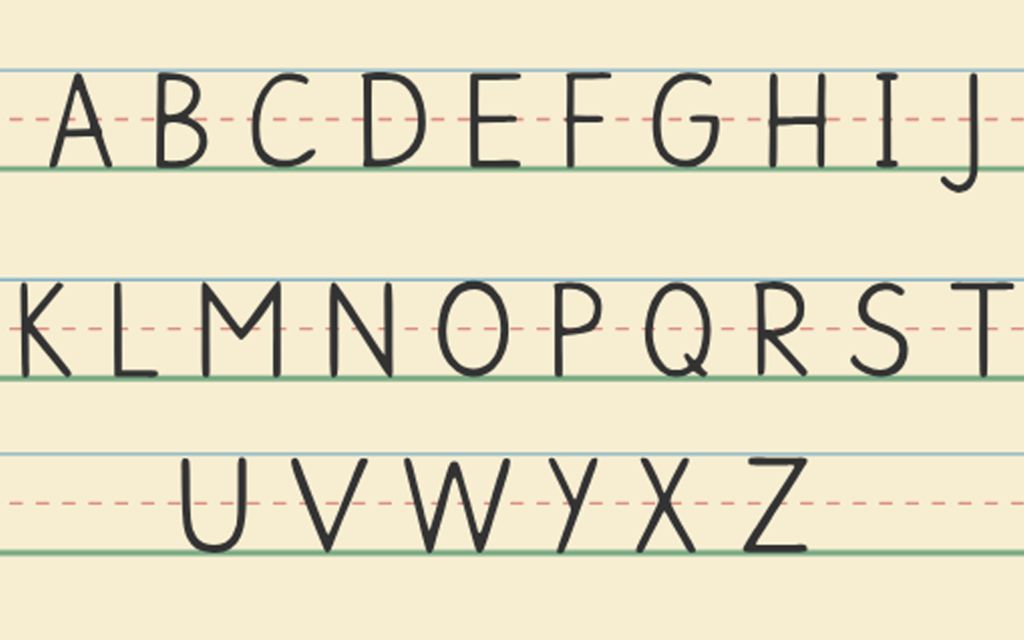
Incorporate Phonics
A phonics-based approach is at the heart of effective reading instruction. Teaching children the connection between letters and sounds helps them decode unfamiliar words. Unlike memorizing sight words alone, phonics gives children a system they can apply to new words.
Phonics instruction should begin with simple consonant-vowel-consonant (CVC) words like “cat,” “dog,” and “hat.” As they grow more comfortable with these, you can move on to blends, digraphs, and long vowels. The key is consistency and repetition—provide plenty of practice without pressure.
To support phonics instruction, use letter tiles, phonics readers, rhyming books, and repetition-based games. Keep sessions short, engaging, and supportive. Make sure children feel successful, even if the step is small. Every positive reading experience builds momentum.
Balance Phonics and Sight Words
While phonics is essential, some words in English don’t follow standard phonetic rules. These are called sight words—like “said,” “the,” “are,” and “was.” A balanced reading strategy includes both phonics instruction and sight word recognition.
Sight words should be introduced gradually, starting with the most frequently used words in children’s books. Use flashcards, sentence-building games, and interactive reading to help children recognize these words instantly.
Don’t overwhelm a child with too many sight words at once. The goal is to slowly build up a bank of automatic words that support fluency. When combined with phonics skills, this approach helps children move from decoding every word to reading with greater ease and understanding.
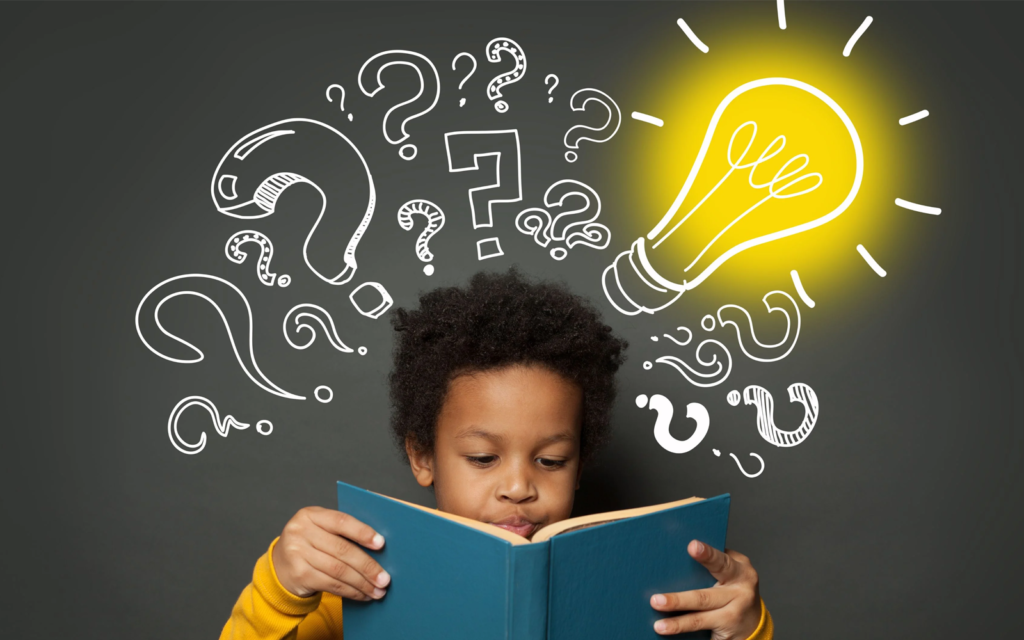
Talk a Lot
Reading begins long before a child can decode letters on a page. Oral language lays the foundation for reading success, so one of the best things you can do is talk a lot. Describe your day, name objects, ask questions, and listen to your child’s responses.
Conversations expose children to vocabulary, sentence structure, and storytelling. They also build the child’s understanding of how language works. Daily interaction with adults who model rich, expressive language helps develop listening comprehension and prepares children for the structure of written texts.
Don’t underestimate the power of storytelling without books. Telling made-up stories, recounting personal experiences, or simply talking through events helps children understand narrative flow and builds their imagination, both crucial for literacy.
Keep It Light
Learning to read should never feel like a test or chore. Keep the tone light, positive, and playful. When a child senses pressure or disappointment, it can lead to anxiety and resistance around reading. Remember, your attitude toward reading will shape theirs.
Use humor, games, and positive reinforcement. Celebrate progress, no matter how small. If a child shows frustration, take a break and come back later. Making reading enjoyable in the early years is more valuable than forcing mastery on a rigid timeline.
Children learn best in relaxed, supportive environments. Create routines around reading—like bedtime stories or morning book time—that become comforting rituals. These moments build emotional connections to reading that will last a lifetime.

Practice Shared Reading
Shared reading is one of the most powerful tools for how to teach kids to read. It involves reading together and actively engaging with the text. You might read aloud while the child follows along, or pause to ask questions and make predictions.
Point to the words as you read. Let the child fill in rhyming words or familiar phrases. Please encourage them to repeat sentences, mimic sounds, or act out parts of the story. These interactions build vocabulary, comprehension, and print awareness.
Make shared reading a daily habit. Choose books that match the child’s interests and reading level. Remember, repetition is beneficial—rereading favorite books helps reinforce language patterns and story structures.
Play Word Games
Play is a child’s natural language, and incorporating games into reading instruction is both practical and enjoyable. Word games help children develop phonemic awareness, letter recognition, and vocabulary without feeling like “learning.”
Try rhyming games, syllable clapping, alphabet scavenger hunts, or matching games using letter cards. You can even make up games on the spot—ask your child to find objects that begin with a particular sound, or play “I spy” with letters and words.
These playful moments activate different areas of the brain and keep reading fun. They also provide opportunities for movement and sensory input, which are essential for young learners.
Read with Unconventional Materials
Books are the foundation, but they’re not the only resource. Children can also learn to read through unconventional materials—magazines, menus, signs, product packaging, and recipe cards. These real-world texts show children how reading connects to daily life.
Label items around the classroom or home to reinforce word-object associations. Use grocery lists, restaurant menus, or street signs to practice word recognition. These casual learning moments often feel more meaningful because they are connected to things the child already understands and cares about.
The goal is to help children see reading everywhere, not just in books. This creates a more immersive literacy environment and encourages curiosity about words in the world around them.
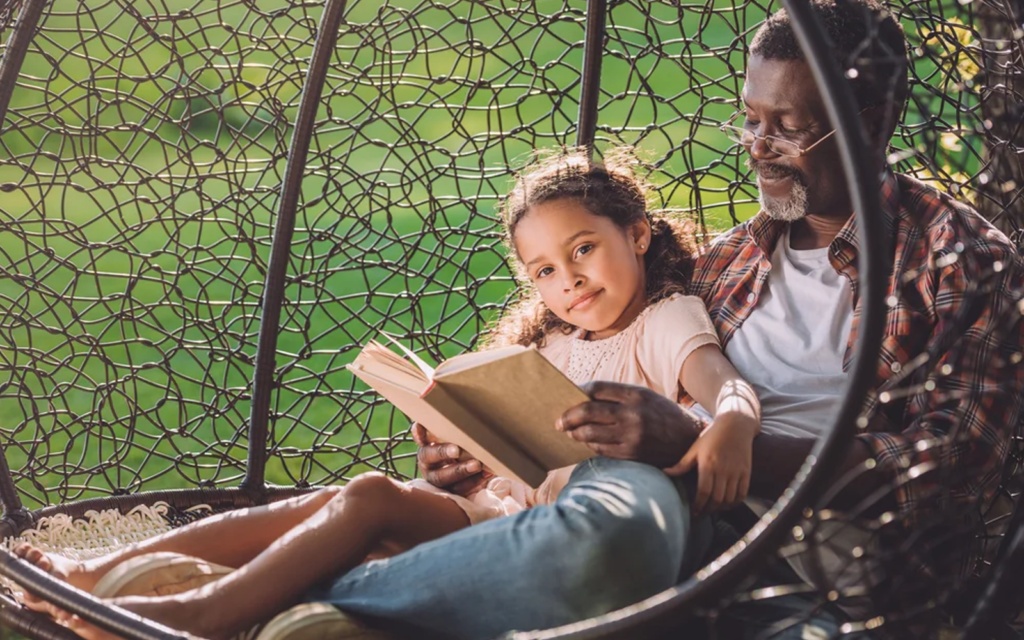
Teach Kids to Read by Creating a Montessori-Inspired Environment
If you’re wondering how to teach kids to read more effectively, the answer may lie not just in your method, but in your environment. A Montessori-inspired reading space can make all the difference in developing a child’s early literacy skills. By carefully preparing the surroundings, children feel empowered to explore books, language, and ideas independently. Here’s how to create a space that supports early reading, using essential Montessori furniture elements.
Start with the Right Bookshelf
In a Montessori environment, a low open bookshelf is more than just storage—it’s an invitation. Books should be front-facing and within easy reach so children can independently choose what they want to read. Organize books by theme, level, or subject using baskets or dividers. A clutter-free bookshelf encourages order, independence, and daily reading habits—all key when you aim to teach kids to read through consistent exposure.
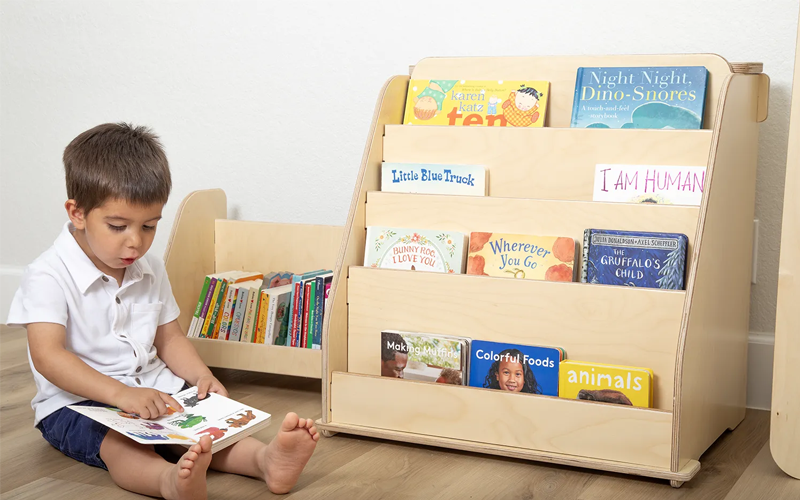
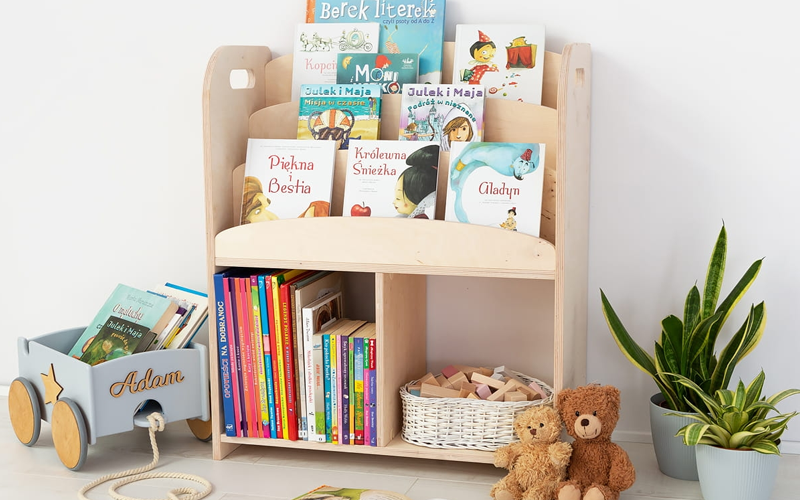
Create a Cozy Reading Corner
A Montessori reading corner is a peaceful, designated space where children can sit and engage with books quietly. Soft rugs, cushions, and natural lighting make this area inviting. Add a few carefully selected books, perhaps rotating them weekly, to keep the environment fresh and focused. When children feel relaxed and comfortable, they are more likely to explore language, increasing both their vocabulary and reading fluency. A well-designed reading corner promotes a love for books and supports sustained attention, a crucial element in learning to read.
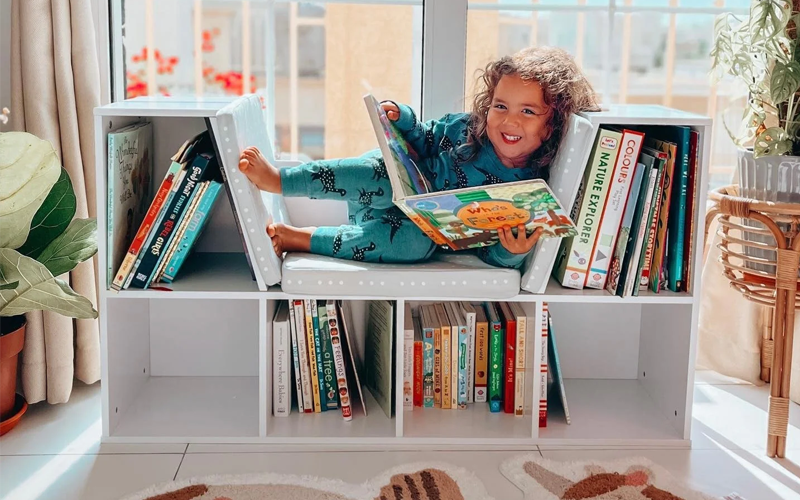
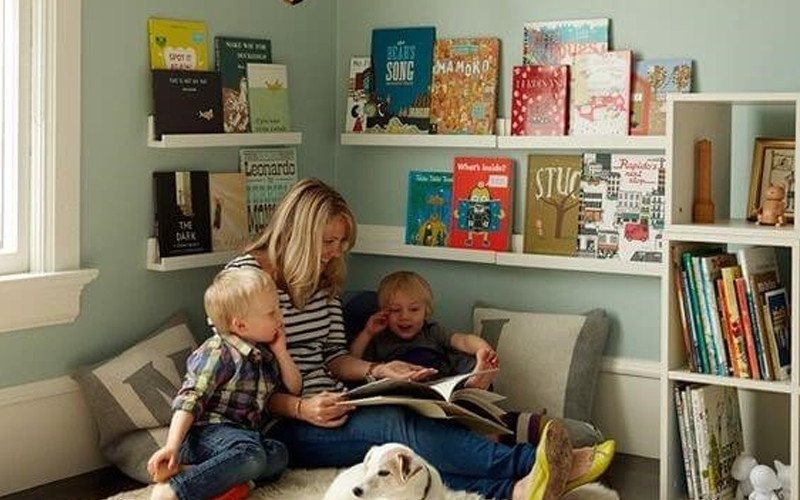
Use Child-Sized Table and Chairs
To truly support independence, include child-sized tables and chairs in your literacy area. This setup allows children to engage in pre-reading activities such as drawing letters, matching sounds to pictures, or tracing words. These activities develop fine motor skills and letter recognition, both of which are necessary when you teach kids to read. Tables should be sturdy, with rounded edges, and chairs should allow the child’s feet to touch the ground—this promotes proper posture and concentration.
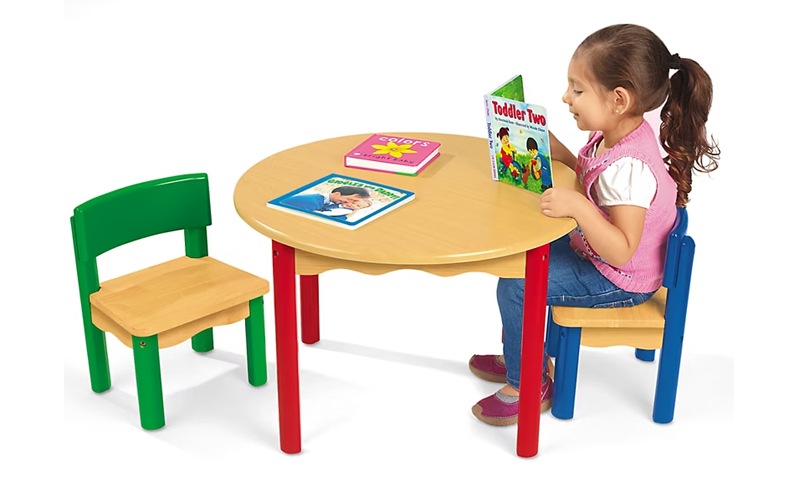
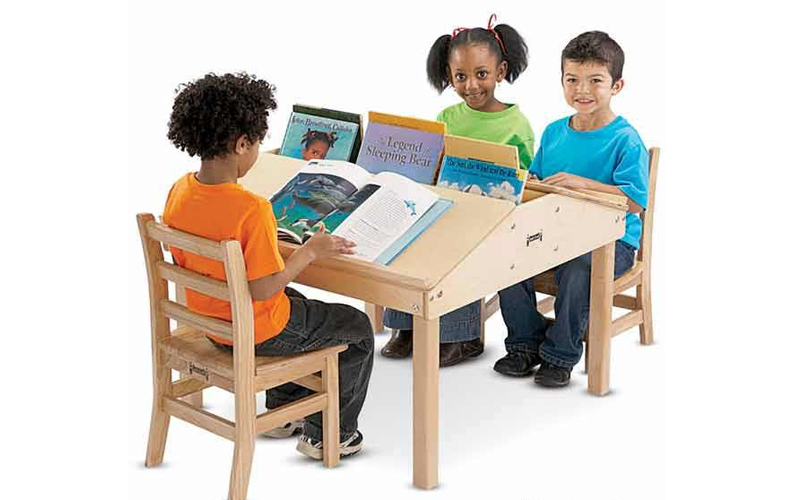
By thoughtfully incorporating a child-centered bookshelf, a calming reading corner, and functional tables and chairs, you are not just furnishing a space—you are designing a literacy environment. When children feel ownership of their learning space, they naturally become more curious, confident, and motivated to read.
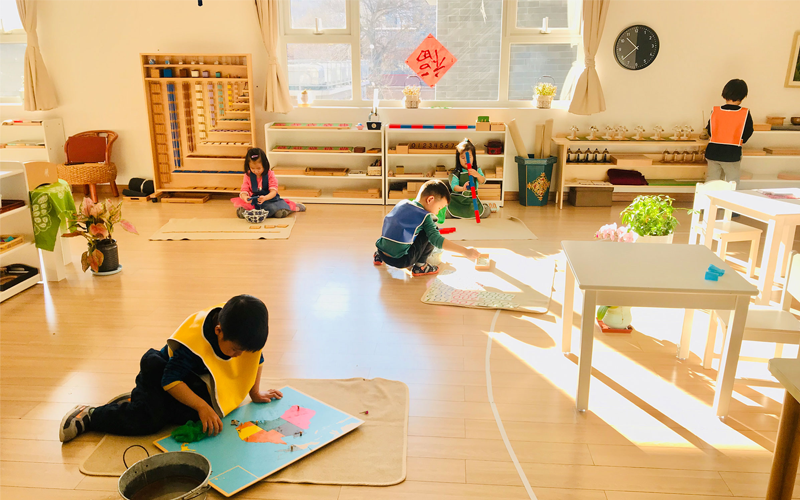
A Montessori-inspired environment empowers children to engage in reading at their own pace, in their way. And that’s precisely how we should aim to teach kids to read—through freedom, structure, and beautifully designed space. Having the best books to teach kids to read is only part of the process. Children need an environment where reading is relaxed, self-directed, and enjoyable. When books are accessible and space is inviting, kids are more likely to read on their own.

When to Teach Kids to Read?
One of the most frequent concerns heard from parents and kindergarten owners is this: When should we start to teach kids to read? Some children seem eager at age three, while others show little interest until age six. The truth is, the answer is not one-size-fits-all. Reading is a developmental process, and success depends on a child’s cognitive, emotional, and physical readiness.
Understanding Reading Readiness
What is Reading Readiness?
Before we look at the “when,” we need to understand what it means to be ready to read, reading readiness refers to a combination of skills, behaviors, and interests that signal a child is prepared to begin decoding written language.
Some of these signs include:
- Recognizing letters and basic sounds
- Enjoying being read to regularly
- Showing interest in books or print on signs and packaging
- Understanding that words convey meaning
- Pretending to read or write during play
When these behaviors are consistently observed, it’s a good sign that the child is ready to begin learning how to read.

Emotional and Social Readiness Matters Too
Cognitive skills are only part of the equation. Children must also have the emotional maturity to sit still for short periods, follow simple instructions, and manage frustration. Rushing to teach kids to read before they can emotionally engage with the process often leads to resistance or anxiety around reading.
A child who enjoys storytime, shows curiosity, and asks questions about letters or words is often more emotionally ready to begin formal instruction.
What Age Is the Right Age?
There’s a Window, Not a Deadline
Most children are ready to learn to read between the ages of 5 and 7, though some begin earlier and others slightly later. In early childhood education, we never push, but we do prepare. From the ages of 3 to 5, our focus should be on building the foundation rather than enforcing reading rules.
Pre-Reading Is Teaching Too
When we talk about how to teach kids to read, we’re not only talking about phonics and decoding. Pre-reading activities are equally essential. These include:
- Daily read-alouds
- Talking about stories
- Singing songs and rhymes
- Letter play through puzzles and toys
- Story sequencing games
- Labeling everyday objects in the environment
These early experiences strengthen vocabulary, phonological awareness, and comprehension—all of which directly support future reading success.
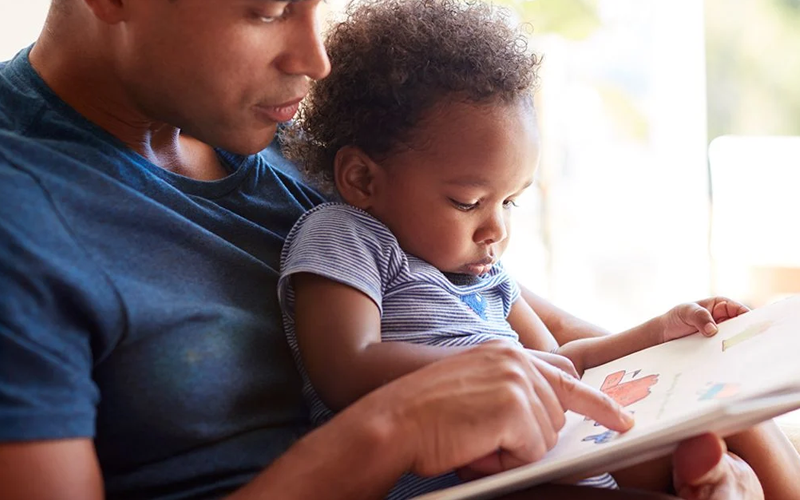
| Age Range | Reading Milestones | What to Focus On |
|---|---|---|
| 0–2 years | – Enjoys being read to – Turns pages of board books – Begins to recognize familiar objects in pictures | – Build listening and early vocabulary – Encourage book-handling habits through daily routines |
| 3–4 years | – Recognizes some letters and symbols – Understands that print carries meaning – Pretends to read or retell simple stories | – Develop print awareness – Begin introducing phonemic sounds and letter recognition – Encourage interest in storytelling |
| 5–6 years | – Sounds out simple CVC words – Begins to recognize common sight words – Reads short sentences with support | – Focus on phonics-based decoding – Introduce sight word practice – Support word blending and reading confidence |
| 6–7 years | – Reads simple books independently – Understands basic story structure – Begins to self-correct when reading aloud | – Strengthen fluency and comprehension – Reinforce vocabulary and sentence structure – Encourage daily independent reading |
| 7–8 years | – Reads paragraphs and short chapters – Makes predictions and inferences – Begins reading silently for meaning | – Develop comprehension strategies – Introduce genre exploration – Promote reading as a daily habit |
How Early Is Too Early?
There’s increasing pressure on parents and teachers to start early, sometimes as young as 3 years old. But here’s the problem: starting too early can do more harm than good.
If a child is pushed before they’re ready, they might associate reading with stress, frustration, or failure. In contrast, a child who starts at the right time—emotionally and developmentally—is more likely to succeed and love reading.
Instead of rushing to teach kids to read before preschool, focus on cultivating curiosity, language exposure, and print awareness. When the foundation is strong, the formal process of reading will feel natural.
Montessori and Reggio-Inspired Timing
In Montessori and Reggio Emilia classrooms, we don’t view reading as a task with a strict age limit. Instead, we see literacy as a process that unfolds through exploration. Children are surrounded by language-rich environments filled with books, signs, labels, and storytelling opportunities. Reading instruction is personalized, based on a child’s readiness, not an imposed timeline.
This approach emphasizes that teaching kids to read isn’t about pushing academics early—it’s about respecting the child’s developmental journey.

Signs That It’s Time to Teach Kids to Read
If you’re unsure whether it’s time to begin formal instruction, look for these key indicators:
- Your child shows interest in books and letters
- They can rhyme or recognize beginning sounds
- They attempt to write or “read” words
- They ask what certain words mean or how to spell them
- They can sit and focus on a short story or an activity
When several of these signs appear consistently, it’s likely time to start teaching them how to read—gently, and with methods tailored to their age and interests.
How to Teach Kids to Read with Dyslexia?
Teaching kids with dyslexia to read is a unique challenge, but with the right approach, tools, and environment, it is achievable. Dyslexia is a neurological difference that affects how the brain processes written language. Children with dyslexia may struggle with decoding, phonemic awareness, and letter-sound recognition, but they are not less intelligent. What they need is a reading method tailored to how they learn best.
Understand the Needs of Kids with Dyslexia
Before you begin to teach kids to read who have dyslexia, it’s essential to understand their learning profile. Dyslexic children often have difficulty connecting sounds to symbols, which makes traditional phonics instruction insufficient on its own. They may read slowly, confuse letters like “b” and “d,” or have trouble remembering word shapes.
However, many dyslexic learners are strong in reasoning, creativity, and problem-solving. Your teaching strategy should tap into their strengths while building foundational reading skills through repetition, multisensory input, and emotional support.
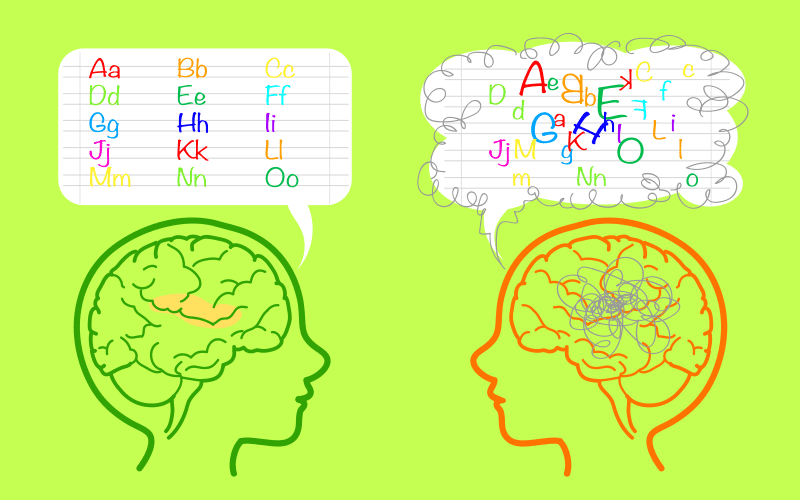
Use a Multisensory, Structured Approach
One of the most effective methods for teaching kids with dyslexia to read is the Orton-Gillingham approach. This method is:
- Explicit: Directly teaches rules and patterns in the English language
- Systematic: Follows a logical sequence that builds from simple to complex
- Multisensory: Engages visual, auditory, and tactile channels to reinforce learning
For example, when teaching the sound of the letter “m,” you can have the child:
- Say the sound out loud
- Trace the letter in the sand
- Read the letter from a card
- Write the letter on paper
By engaging multiple senses, dyslexic learners form stronger neural connections, making it easier to retain and apply what they’ve learned.
Focus on Phonemic Awareness and Fluency
To teach kids to read effectively—especially those with dyslexia—you must dedicate time to phonemic awareness. This means helping children hear and manipulate individual sounds in words.
Daily exercises might include:
- Clapping out syllables
- Blending sounds into words (e.g., /c/ /a/ /t/ → cat)
- Segmenting spoken words into individual phonemes
Once phonemic awareness improves, you can transition to fluency-building with decodable readers that match their current skill level. These books should emphasize controlled vocabulary, repeated sentence patterns, and consistent phonetic rules.

Build a Supportive Reading Environment
Children with dyslexia often experience frustration and low confidence. That’s why it’s essential to create an environment where mistakes are seen as part of learning. Celebrate progress—even small steps. Keep reading sessions short, positive, and consistent.
Use tools like:
- Audiobooks for listening practice
- Reading trackers to help maintain focus
- Colored overlays for better visual processing
- Books with larger fonts and clean spacing
Adding supportive furniture—such as ergonomic chairs and focused reading tables—can also improve posture and concentration during reading activities. As always, access to a well-organized, low bookshelf allows children to choose decodable or interest-based books independently, supporting literacy autonomy.
Collaborate with Families and Specialists
When teaching kids with dyslexia to read, consistency across home and school makes a big difference. Share strategies with families, provide reading materials for at-home practice, and stay in touch with any reading or language therapists the child may be working with.
Regular communication ensures that everyone is using the same language, cues, and pacing, which gives the child the stability they need to grow.

Best Books for Teaching Kids to Read at Home or in the Classroom
Finding the best books to teach kids to read can make a significant difference in a child’s early literacy journey. Whether you’re a parent supporting reading at home or a teacher guiding students in the classroom, the right books lay the foundation for strong decoding skills, comprehension, and a lifelong love of reading. The key is selecting books that are developmentally appropriate, engaging, and supportive of a structured reading approach.
What Makes a Great Early Reading Book?
Before choosing titles, it’s essential to understand what makes a book effective for teaching kids to read. High-quality early readers should include:
- Simple sentence structure
- Repetitive language patterns
- Phonetically decodable words
- Clear illustrations that support word meaning
- Gradual introduction of sight words
Books that follow these guidelines help children build confidence and reading fluency. They allow kids to apply phonics knowledge, recognize word patterns, and practice oral reading with success.
Recommended Books and Series
Brand-Supported Decodable Readers: Bob Books (by Bobby Lynn Maslen)
The Bob Books series is widely used in both homes and classrooms for teaching kids to read. These small, leveled readers start with short vowel sounds and basic CVC (consonant-vowel-consonant) words like “Sam” or “cat.” The simple drawings and progressive levels make them perfect for beginning readers.
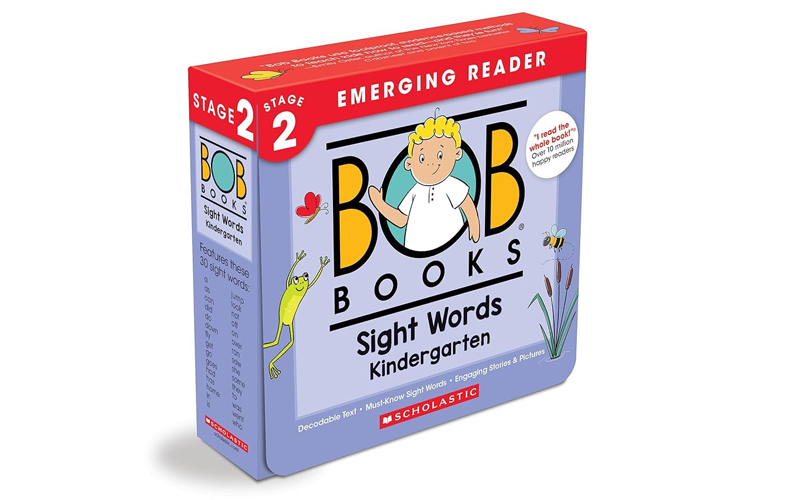
Usborne Very First Reading
This series blends shared reading between adult and child, with the first few lines read by the parent and the rest by the child. It introduces phonics systematically, making it one of the best books to teach kids to read in guided reading settings. The colorful illustrations and charming stories add motivation for young readers.
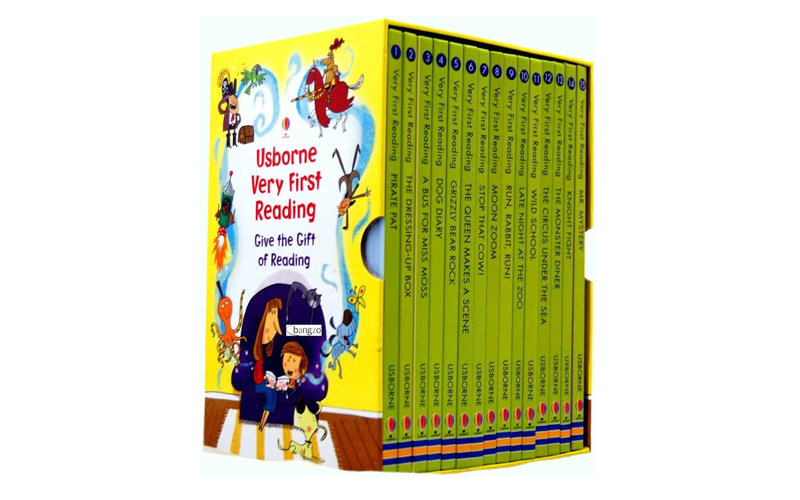
Elephant and Piggie Series (by Mo Willems)
While not traditional phonics books, the Elephant and Piggie books are excellent for building fluency and comprehension. Their predictable, repetitive dialogue and expressive illustrations help children connect language with emotion and context. They’re ideal for classroom group reading or light reading at home.
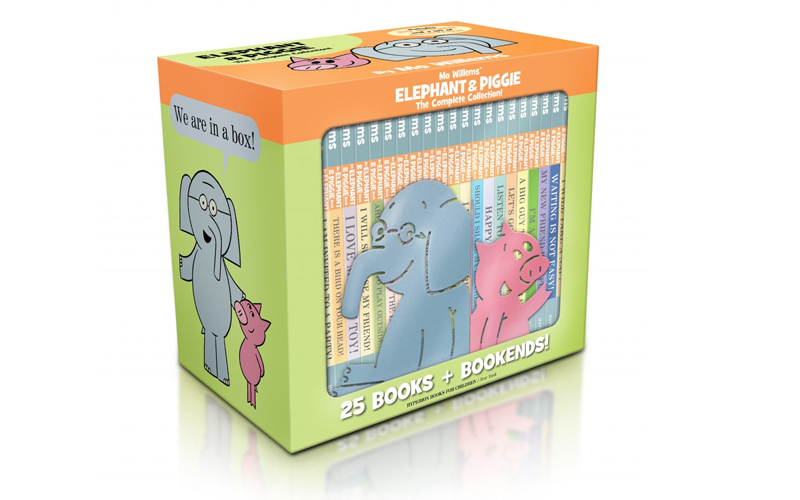
Brand-Supported Decodable Readers
Many educational publishers, including Scholastic and Pearson, offer decodable books tied to specific phonics levels. These are particularly effective when used alongside a phonics curriculum in a Montessori or Reggio-inspired learning environment. They allow educators to teach kids to read in a logical, sequential way, aligning with classroom instruction.

FAQs
1. What are the best books to teach kids to read at home?
Some of the best books to teach kids to read at home include the Bob Books series, Usborne Very First Reading, and Elephant and Piggie by Mo Willems. These books are designed for early readers, with simple words, repetitive structures, and engaging illustrations that support comprehension and confidence.
2. How do I know if a book is suitable for teaching kids to read?
A good early reader should include short sentences, decodable words, repetition, and pictures that support phrase meaning. If the book builds confidence and allows the child to apply phonics knowledge easily, it’s suitable for teaching kids to read.
3. Can I use these books both at home and in the classroom?
Yes. All the recommended titles are suitable for both home and school use. Whether you’re a parent or an educator, consistency in using the best books to teach kids to read across environments helps children reinforce skills and make faster progress.
4. Are decodable books better than picture books for beginners?
Decodable books are specifically designed for early readers learning phonics. While picture books support listening comprehension, decodable readers are more effective for teaching kids to read independently. Both have their place in a balanced reading program.
5. How can I set up a reading area to encourage early reading?
Create a reading-friendly space with:
- A low, front-facing bookshelf
- A quiet reading corner with cushions
- Child-sized table and chairs
This setup allows children to explore the best books to teach kids to read independently in a comfortable, engaging environment.
6. How many times should a child read the same book?
Repetition is key when teaching kids to read. Encourage your child to read the same book several times over a few days. This builds fluency, boosts memory, and increases confidence in word recognition and sentence patterns.
Conclusion
Creating a successful early reading journey starts with the right tools and environment. By selecting the best books to teach kids to read, such as Bob Books, Usborne First Reading, and decodable phonics series, you give children the structure they need to build confidence and fluency. Whether at home or in the classroom, combining strong book choices with a Montessori-inspired setup—like low bookshelves, cozy reading corners, and child-sized tables and chairs—creates a space where reading becomes part of a child’s natural development. If you’re committed to teaching kids to read effectively, start with the right books, the right environment, and the belief that every child can become a reader, with the proper support at the right time.

